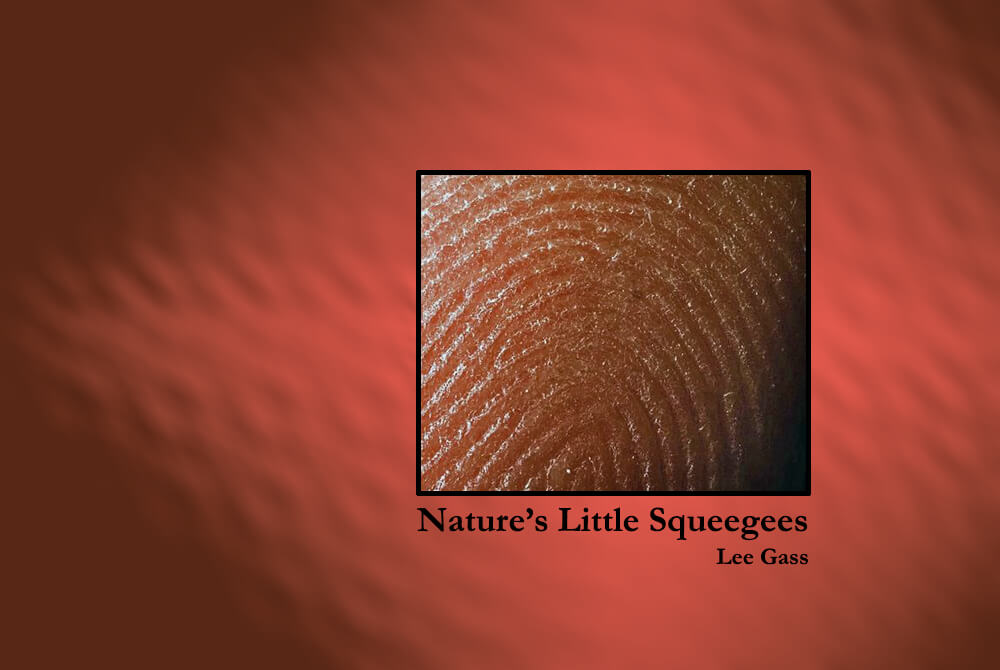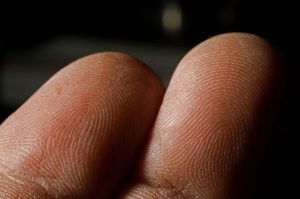Nature’s Little Squeegees
If you’ve spent hours
sanding rocks or furniture without
gloves, you may have noticed something
that fascinates me every time it happens. I
knew as a child that, like snowflakes, fingerprints
are unique. Aside from the obvious usefulness of
that fact to police and fortune tellers, I wonder-
ed why we have those swirling ridges
on our fingertips at all.
To couch that wonderment
in biological terms, how do fingerprints
contribute to our fitness? What difference does
it make to survival or reproduction that we have them?
How, in our evolutionary history, did we come to have
fingerprints? Those questions simmered in the back
of my mind for decades. I wondered about them
from time to time, but didn’t really do
anything to answer them.
When I got
serious about carving
in the early ‘80s, I realized
suddenly that fingerprints
are damn good things to
have, biologically.
During the week of
my 40th birthday, in late winter
1982, I declared I would behave as if sculpting
were my life’s work and everything changed for me
in that moment. I was fully engaged in research
and teaching at the time and couldn’t spend
much time at my new passion, but my
declaration to behave as if was
The Birth of a Sculptor.
It transformed
the quality of my experience
of sculpting, increased the quality
and quantity of my production as a
sculptor, and transformed my
presence in the university.
Along with one or
two larger-than-a-breadbox sculptures
I managed to produce each year on weekends
and evenings, I always had 1 or 2 small sculptures
on the go. I carried them and tools to work on them
everywhere in a butt pack. When I arrived for long
meetings like PhD defenses or committee meetings,
I spread a towel on the table before me and
sanded quietly and unobtrusively
throughout the meeting.
As I explained in
Secrets of Silence in the Class-
room, keeping my hands busy helped me
keep my mouth shut and my mind open, raised
the quality of my listening, and allowed me to contribute
more effectively to whatever the meeting was about. On
days with many meetings, I sanded 5 or 6 hours then
worked on larger pieces in my studio at night.
Two consequences followed from this
activity, both predictable and both
significant in my life.
I developed tennis
elbow, had to demand less of
my aging body, and stopped carving
small sculptures for that reason. I
also realized what fingerprints are
about biologically. Here’s
how it happened.
A good way to
sand is to fold the sandpaper
in thirds – I call it a three-fold. The
first third sands the rock, the third third
“bites” the back of the first, keeping the package
together, and the second third is a non-slip
surface to push against. Refolding it
twice keeps fresh abrasive biting
stone til it’s time to fold a new
piece and start over.

To shape and smooth
small concavities of Flight from
the Island, for example I used 3-folds as
short as an inch and less than a quarter that
wide. Many hundreds of times an hour, I plowed
silicon carbide crystals through stone, producing
a respectable amount of stone dust on the towel
during any one meeting. That system worked
great for sanding sculptures and keeping
my mouth shut. It also wore away
my fingerprints, sometimes til
my fingers bled.
Suddenly my mind
opened to the significance of
fingerprints when I realized that
soap doesn’t rinse off my body as well
in the shower without crisp, clear finger-
prints to help me wipe it away. Unless I
am especially careful washing dishes,
they slip out of my hands and break.
It is dangerous
to work without fingerprints!
What fingerprints are,
I came to believe, is hundreds of
tiny squeegees wiping away moisture in
all directions, ensuring good grip on wet, slimy,
or smooth surfaces, allowing us to handle them
safely, surely, and effectively. They allow us to
trust our hands to do what hands can do
and let us down if they’re not there.
Fingerprints are like treads
on tires.
Realizing those
advantages of fingerprints let
me adjust, saving dinnerware and
allowing me to enjoy showering despite the
slow-rinse effect. It deepened my appreciation
of the many grip-enhancing features of the toes
of lizards and other animals that rely critically
on their fingertips in making their way in
the world. How fingerprints came to
be unique, however, I still don’t
have a clue about.
The fingerprints
below are on the index and
middle fingers of my left hand. My
right prints were worse and would have
been interesting but left handed picture
taking is difficult with heavy cameras.
The image at the
top zooms in on the most worn
part of my left middle finger, and shows
the pattern of wear a week after I spent half
a day sanding a large concave surface of basalt,
in my studio and not in a meeting. In the
photos, my prints are about half
grown back. Examine
the pattern.
My worn prints
are graphs of the erosion they’ve
incurred. In their pattern of wear, they record
evidence of what they’ve been doing. On both fingers,
wear peaks toward the tips of fingers from finger-
print whorls. It takes certain sets of forces,
accumulated over time, to make prints
wear like that. To Sherlock, that
would be elementary.
To sand stone,
I must apply two kinds of forces
to the surface. I must push straight in
for particles to dig into the stone: what we
call the “normal” direction. I must also
push the abrasive tangentially along
the surface, scratching grooves
in it with the particles.
The greater
the normal force,
the deeper the scratch.
The greater the tangential
force, the faster the
stroke and the
more dust.
On curved
surfaces, tangents and
normals change continuously
as I sand, and some parts of the stone
wear away faster than others. Patterns
of wear in my fingerprints illustrate what
physicists call the ‘resultant’ of those two
forces as they accumulated
over time.
If I sand
stone for hours, days, and
sometimes weeks on end, patterns
of wearing down build up, and if I’m
careless or overdo it my skin gives way
and bleeds on what I’m working on.
Then I must wait for my prints
to come back before I can
get into it again.
As stresses
relax and fingertips
heal, the new prints are
exactly the same as
the old ones.
Something I Admire
about Surgeons is another story
about sculpting and fingerprints. Lactate Burn
is about those same forces, but in relation to muscles
moving sandpaper and consequences for form,
not what that does to fingertips.
In the podcast
Engagement is Visceral, I
argue something related, which
is that learning happens in
our bodies: what I call
“in the meat”.
When a friend
who is an RCMP constable
visited my studio and I showed him
my prints, he was very interested. He realized
that our fingerprints reveal more about us
than simply our identity.
First published in the Vancouver Observer.
Edited February 2021




Prior to the mid 1980’s it wasn’t common for dentists to wear gloves when treating patients for non-surgical procedures. Tactile sensitivity was lost to the dentist when latex gloves became used. The gloves would slip around on our fingers when holding small tools, causing some loss of control. But we learned to adapt and developed compensating techniques. Today, I use gloves when sculpting, as much as possible. I don’t tire as much. And I am forced to remove the glove from time to time to explore the texture with sensitive still sensitive fingers and gain a whole new understanding of contour and texture…through touch!